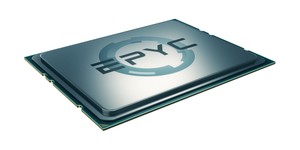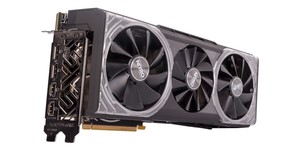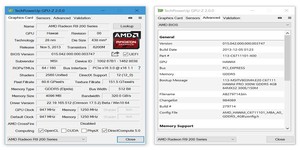
AMD has officially unveiled a raft of high-end products aimed at the enthusiast, data centre, and workstation markets, including a new name for its Naples server family: Epyc.
Unveiled by AMD chief executive Lisa Su during the company's financial analyst day, the bulky Epyc processor range is designed to compete directly with rival Intel's Xeon family. In its initial incarnation, the processor family formerly known as Naples scales to 32 cores and 64 threads per socket and two sockets per server with no word on a potential four-socket variant. The chips are designed, where they can, to equal or better Intel's equivalents: up to 128 PCI Express 3.0 channels embedded directly into the system-on-chip (SoC) design, eight DDR4 memory channel per socket for up to 4TB per server, what AMD describes as a 'highly-optimised cache structure', and an Infinity Fabric coherent interconnect for linking two Epyc chips together in a dual-socket system.
'With the new Epyc processor, AMD takes the next step on our journey in high-performance computing,' crowed Forrest Norrod, senior vice president and general manager of enterprise, embedded and semi-custom products at AMD. 'AMD Epyc processors will set a new standard for two-socket performance and scalability. As we demonstrated today, we see further opportunity with the industry’s first no-compromise one-socket solutions. We believe that this new product line-up has the potential to reshape significant portions of the datacenter market with its unique combination of performance, design flexibility, and disruptive TCO.'
At the same time, AMD unveiled the Radeon Vega Frontier Edition graphics card, the first commercial product built around its next-generation Vega graphics architecture. Designed for machine learning and advanced visualisation in the data centre and workstation markets, the card boasts 64 Vega compute units with a total of 4,096 stream processors linked to 16GB of High Bandwidth Memory 2 (HBM2) video RAM for an estimated 25 trillion floating point operations per second (teraflops) in FP16 precision and 13 teraflops at FP32 precision. According to AMD's internal testing, that equates to a 30 percent uplift over the most powerful machine-learning GPUs available today and a 42 percent uplift over the Nvidia Titan Xp for 'selected professional applications'.
For the enthusiast, AMD also shared a 'client compute' update with the announcement of a new top-end Ryzen chip: Ryzen Threadripper. Designed to sit at the very top of the Ryzen tree, the Threadripper boasts 16 cores and 32 threads with expanded memory and input-output bandwidth compared to the existing Ryzen 7 family. No official launch date was offered beyond the promise of 'summer 2017' availability, which puts it slightly ahead of the entry-level Ryzen 3 CPU family with a third-quarter launch schedule. At the same time, AMD confirmed that Ryzen mobile accelerated processing units (APUs) codenamed Raven Ridge and offering four cores and eight threads with embedded Vega-architecture graphics would be heading to devices in the second half of the year. Finally, Ryzen Pro - the company's business-centric processor family - is scheduled to land in the second half of the year on the desktop and in the first half of 2018 for mobile devices.
Towards the end of AMD's presentations, the company offered a brief overview of its roadmap for future processors. Zen 2 and Zen 3, the company claimed, will be 7nm process parts, while Vega will be replaced by Navi on the same 7nm process. The company also promised to extend its Infinity Fabric interconnect technology beyond the data centre and workstation markets, hinting at 'highly-scalable SoCs and platforms that meet the growing demand for high-performance compute and graphics technologies'.
Details on Epyc and the Radeon Vega Frontier Edition can be found on their respective product pages, though AMD has yet to add Ryzen Threadripper documentation to its website at the time of writing.
Unveiled by AMD chief executive Lisa Su during the company's financial analyst day, the bulky Epyc processor range is designed to compete directly with rival Intel's Xeon family. In its initial incarnation, the processor family formerly known as Naples scales to 32 cores and 64 threads per socket and two sockets per server with no word on a potential four-socket variant. The chips are designed, where they can, to equal or better Intel's equivalents: up to 128 PCI Express 3.0 channels embedded directly into the system-on-chip (SoC) design, eight DDR4 memory channel per socket for up to 4TB per server, what AMD describes as a 'highly-optimised cache structure', and an Infinity Fabric coherent interconnect for linking two Epyc chips together in a dual-socket system.
'With the new Epyc processor, AMD takes the next step on our journey in high-performance computing,' crowed Forrest Norrod, senior vice president and general manager of enterprise, embedded and semi-custom products at AMD. 'AMD Epyc processors will set a new standard for two-socket performance and scalability. As we demonstrated today, we see further opportunity with the industry’s first no-compromise one-socket solutions. We believe that this new product line-up has the potential to reshape significant portions of the datacenter market with its unique combination of performance, design flexibility, and disruptive TCO.'
At the same time, AMD unveiled the Radeon Vega Frontier Edition graphics card, the first commercial product built around its next-generation Vega graphics architecture. Designed for machine learning and advanced visualisation in the data centre and workstation markets, the card boasts 64 Vega compute units with a total of 4,096 stream processors linked to 16GB of High Bandwidth Memory 2 (HBM2) video RAM for an estimated 25 trillion floating point operations per second (teraflops) in FP16 precision and 13 teraflops at FP32 precision. According to AMD's internal testing, that equates to a 30 percent uplift over the most powerful machine-learning GPUs available today and a 42 percent uplift over the Nvidia Titan Xp for 'selected professional applications'.
For the enthusiast, AMD also shared a 'client compute' update with the announcement of a new top-end Ryzen chip: Ryzen Threadripper. Designed to sit at the very top of the Ryzen tree, the Threadripper boasts 16 cores and 32 threads with expanded memory and input-output bandwidth compared to the existing Ryzen 7 family. No official launch date was offered beyond the promise of 'summer 2017' availability, which puts it slightly ahead of the entry-level Ryzen 3 CPU family with a third-quarter launch schedule. At the same time, AMD confirmed that Ryzen mobile accelerated processing units (APUs) codenamed Raven Ridge and offering four cores and eight threads with embedded Vega-architecture graphics would be heading to devices in the second half of the year. Finally, Ryzen Pro - the company's business-centric processor family - is scheduled to land in the second half of the year on the desktop and in the first half of 2018 for mobile devices.
Towards the end of AMD's presentations, the company offered a brief overview of its roadmap for future processors. Zen 2 and Zen 3, the company claimed, will be 7nm process parts, while Vega will be replaced by Navi on the same 7nm process. The company also promised to extend its Infinity Fabric interconnect technology beyond the data centre and workstation markets, hinting at 'highly-scalable SoCs and platforms that meet the growing demand for high-performance compute and graphics technologies'.
Details on Epyc and the Radeon Vega Frontier Edition can be found on their respective product pages, though AMD has yet to add Ryzen Threadripper documentation to its website at the time of writing.

MSI MPG Velox 100R Chassis Review
October 14 2021 | 15:04








Want to comment? Please log in.